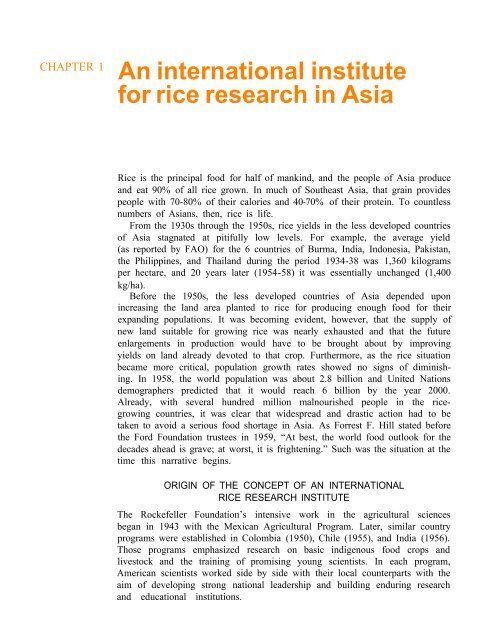An adventure in applied science - IRRI books - International Rice ...
An adventure in applied science - IRRI books - International Rice ...
An adventure in applied science - IRRI books - International Rice ...
- No tags were found...
You also want an ePaper? Increase the reach of your titles
YUMPU automatically turns print PDFs into web optimized ePapers that Google loves.
CHAPTER 1<strong>An</strong> <strong>in</strong>ternational <strong>in</strong>stitutefor rice research <strong>in</strong> Asia<strong>Rice</strong> is the pr<strong>in</strong>cipal food for half of mank<strong>in</strong>d, and the people of Asia produceand eat 90% of all rice grown. In much of Southeast Asia, that gra<strong>in</strong> providespeople with 70-80% of their calories and 40-70% of their prote<strong>in</strong>. To countlessnumbers of Asians, then, rice is life.From the 1930s through the 1950s, rice yields <strong>in</strong> the less developed countriesof Asia stagnated at pitifully low levels. For example, the average yield(as reported by FAO) for the 6 countries of Burma, India, Indonesia, Pakistan,the Philipp<strong>in</strong>es, and Thailand dur<strong>in</strong>g the period 1934-38 was 1,360 kilogramsper hectare, and 20 years later (1954-58) it was essentially unchanged (1,400kg/ha).Before the 1950s, the less developed countries of Asia depended upon<strong>in</strong>creas<strong>in</strong>g the land area planted to rice for produc<strong>in</strong>g enough food for theirexpand<strong>in</strong>g populations. It was becom<strong>in</strong>g evident, however, that the supply ofnew land suitable for grow<strong>in</strong>g rice was nearly exhausted and that the futureenlargements <strong>in</strong> production would have to be brought about by improv<strong>in</strong>gyields on land already devoted to that crop. Furthermore, as the rice situationbecame more critical, population growth rates showed no signs of dim<strong>in</strong>ish<strong>in</strong>g.In 1958, the world population was about 2.8 billion and United Nationsdemographers predicted that it would reach 6 billion by the year 2000.Already, with several hundred million malnourished people <strong>in</strong> the ricegrow<strong>in</strong>gcountries, it was clear that widespread and drastic action had to betaken to avoid a serious food shortage <strong>in</strong> Asia. As Forrest F. Hill stated beforethe Ford Foundation trustees <strong>in</strong> 1959, “At best, the world food outlook for thedecades ahead is grave; at worst, it is frighten<strong>in</strong>g.” Such was the situation at thetime this narrative beg<strong>in</strong>s.ORIGIN OF THE CONCEPT OF AN INTERNATIONALRICE RESEARCH INSTITUTEThe Rockefeller Foundation’s <strong>in</strong>tensive work <strong>in</strong> the agricultural <strong>science</strong>sbegan <strong>in</strong> 1943 with the Mexican Agricultural Program. Later, similar countryprograms were established <strong>in</strong> Colombia (1950), Chile (1955), and India (1956).Those programs emphasized research on basic <strong>in</strong>digenous food crops andlivestock and the tra<strong>in</strong><strong>in</strong>g of promis<strong>in</strong>g young scientists. In each program,American scientists worked side by side with their local counterparts with theaim of develop<strong>in</strong>g strong national leadership and build<strong>in</strong>g endur<strong>in</strong>g researchand educational <strong>in</strong>stitutions.

















